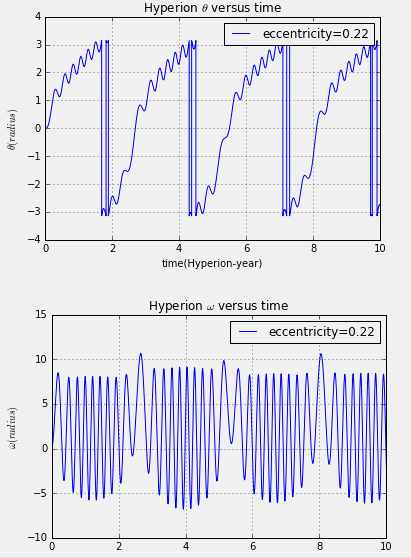Problem4.19:Study the behavior of our model for Hyperion for different initial conditions.Estimate the Lyapunov exponent .Examine how this exponent varies as a function of the eccentricity of the orbit.
公式:
正文
import numpy as np
import pylab as pl
import math
class hyperion:
def __init__(self,x0=1,y0=0,vx=0,vy=2*math.pi,dt=0.0001,total_time=10,initial_theta=0,initial_omega=0):
self.x=[x0]
self.y=[y0]
self.r=[math.sqrt(x0**2+y0**2)]
self.vx=[vx]
self.vy=[vy]
self.dt=dt
self.t=[0]
self.tt=total_time
self.th=[initial_theta]
self.om=[initial_omega]
self.a=0
self.b=0
self.ecc=0
self.dtheta=[]
def run(self):
while self.t[-1]math.pi:
self.th[-1]-=2*math.pi
elif self.th[-1]<-math.pi:
self.th[-1]+=2*math.pi
self.t.append(self.t[-1]+self.dt)
self.a=(max(self.x)-min(self.x))/2
self.b=(max(self.y)-min(self.y))/2
self.ecc=math.sqrt(math.fabs(self.a**2-self.b**2))/self.a
def showth(self):
pl.title("Hyperion $\\theta$ versus time")
pl.xlabel("time(Hyperion-year)")
pl.ylabel("$\\theta (radius)$")
pl.xlim(0,10)
pl.plot(self.t, self.th,label="eccentricity=%.2f"%self.ecc)
pl.legend()
pl.grid(True)
pl.show()
def showom(self):
pl.title("Hyperion $\\omega$ versus time")
pl.xlabel("time(Hyperion-year)")
pl.ylabel("$\\omega (radius)$")
pl.xlim(0,10)
pl.plot(self.t, self.om,label="eccentricity=%.2f"%self.ecc)
pl.legend()
pl.grid(True)
pl.show()
#plot theta or omega versus time
a=hyperion()
a.run()
a.showth()
a=hyperion()
a.run()
a.showom()
#plot delta theta versus time and calculate the lyapuniv exponent
class qwer(hyperion):
def haha(self):
_d=0.01
_vy=2*math.pi-1.1
a=hyperion(vy=_vy)
a.run()
print(a.ecc)
tempth1=a.th
a=hyperion(vy=_vy,initial_theta=_d)
a.run()
tempth2=a.th
for i in range(len(tempth2)):
a.dtheta.append(math.log(math.fabs(tempth2[i]-tempth1[i])))
pl.plot(a.t,a.dtheta,label="eccentricity=%.4f"%a.ecc)
dd=[]
tt=[]
for j in range(len(a.dtheta)):
dd.append(a.dtheta[j])
tt.append(a.t[j])
z=np.polyfit(tt,dd,1)
p=np.poly1d(z)
print(p)
linspx=np.linspace(0,8)
linspy=z[0]*linspx+z[1]
pl.plot(linspx,linspy,label="lyapunov exp=%.4f"%z[0])
pl.xlabel("time(Hyperion-year)")
pl.ylabel("$\\Delta\\theta(radius)$")
pl.title("Hyperion $\\Delta\\theta$ versus time for initial $\\Delta\\theta$=%.3f"%_d)
pl.legend()
b=qwer()
b.haha()
结论:
可见Lyapunov exponent会随轨道偏心率的变化而改变。
致谢:
感谢秦大粤同学的热心帮助!






